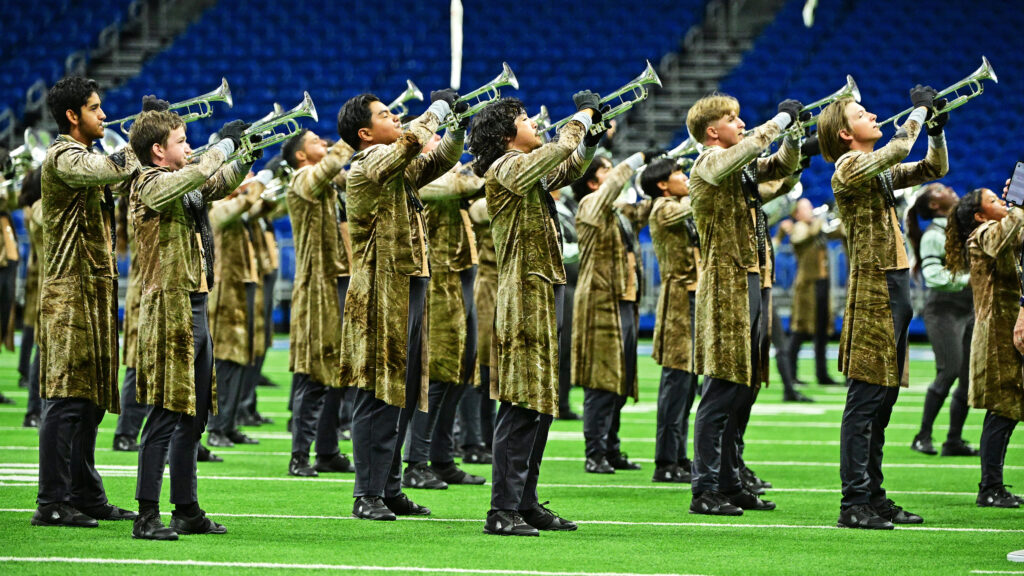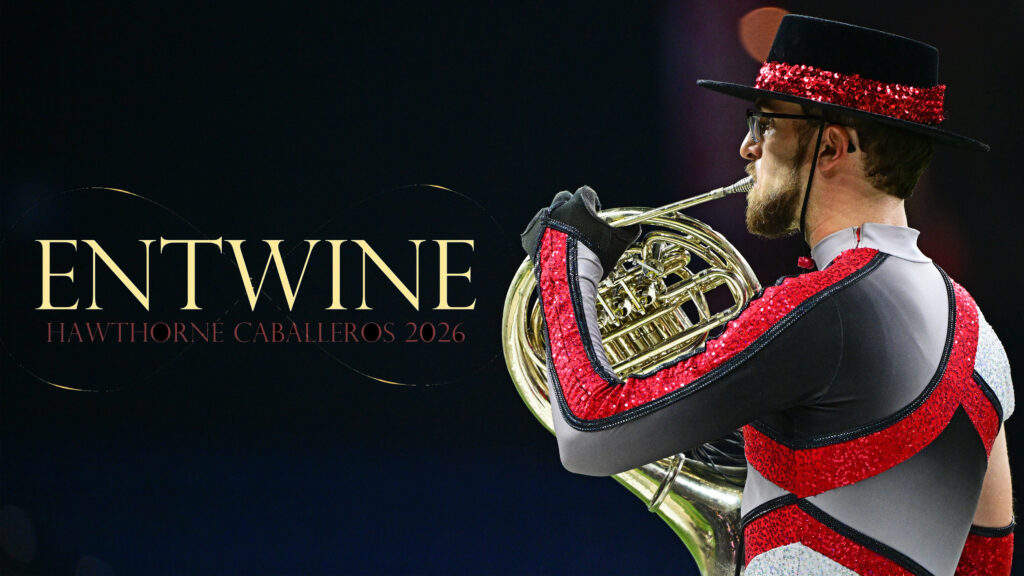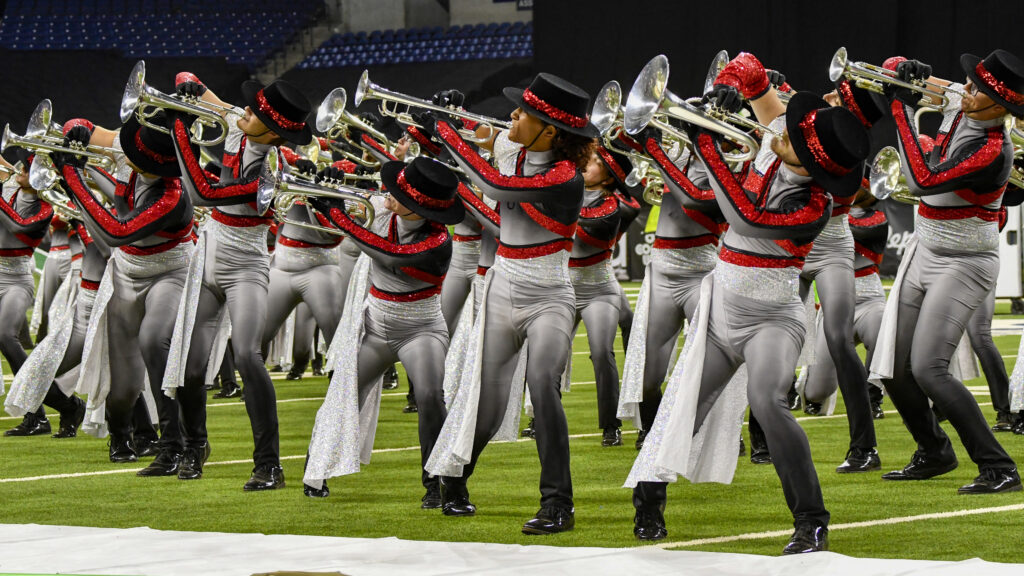2010 marked the second year that the DCI World Championships headed to Lucas Oil Stadium in downtown Indianapolis.
Among the top-17 Semifinalist corps, the Colts placed 13th for the fourth time in five years, followed by Academy, Troopers, Spirit and Crossmen.
In 2006, Academy won the Division II World Championship title in its first year competing at the DCI World Championships. The following year, the corps entered Division I (World Class) competition, placing 13th, just a point shy of earning a spot as a top-12 finalist. Slipping to 18th in 2008, the corps rebounded to 14th the following two years.

Academy’s 2010 “Strangers in Paradise” production was mostly based on the music of Alexander Borodin’s “Prince Igor,” a work started in 1868 that is noted as one of Russia’s most important historical operas. Before dedicating himself to developing a Russian classical music not indebted to the music of Western Europe, Borodin was both a doctor and a chemist. Unfortunately, he died in 1877 before the opera was finished, and so friend Nikolai Rimsky-Korsakov and his private student Alexander Glazunov completed the opera, with Glazunov creating the work’s overture from several of Borodin’s sketches.
The Tempe, Arizona corps’ show didn’t tell a literal story, although there were moments when one might think that. The color guard at times portrayed whirling dervishes, and a central female character gave an impression there might be a romantic subtext with male members of the guard who represented the brawn of warriors. However, Academy staff members claimed the show was non-programmatic.
“Strangers in Paradise” opened with that overture, which contains parts of “Polovtsian Dances,” a segment of the opera that was performed prior to Borodin’s death. The work, set in the late 12th Century, told the story of Prince Igor leading the Russians across the Steppes of Central Asia to battle the Polovtsians, a brutal nomadic tribe originally from Turkey that regularly attacked the south of Russian.

Color guard members were dressed in red Cossack-style costumes, moving behind the corps to where they picked up solid red flags for the fanfare proclamation of the melody best known as “Stranger in Paradise.” That popular tune is from the 1953 musical “Kismet,” which mostly contains songs based on Borodin’s music. In a pre-season press release, the Academy announced that visual cues were taken both from the opera and the musical. Those images were said to offer a sense of color and wonder that is conjured by thinking of escapades far from the reality of everyday life.
“Selections from the ‘Prince Igor’ Opera” contained a number of vivacious themes highlighted by drill formation evolutions that went from blocks to swirls and from swirls to blocks. The piece ended with all the color guard flags spread across the front of the field.
Next came “Aquarium,” which is the seventh of 14 movements from Camille Saint-Saëns’ “Carnival of the Animals,” composed by the French romanticist in 1866. The suite wasn’t published until 1922, however, a year after the composer’s death, due to Saint-Saëns’ insistence. The composer gave this curious instruction because he feared the light-hearted work would cause him to no longer be considered a serious composer.

“Aquarium” is one of the two movements of the suite that incorporated a glass harmonica, in which fingers on spinning glass disks produce the sound. Today, celeste or orchestra bells typically play that part. It was utilized as the Academy’s percussion feature, mostly for the front ensemble section, and was accompanied by dancing color guard members. At the very end of the piece, those performers changed costumes to purple blouses and striped pants.
Next were a number of selections from “Polovstian Dances,” which, as the most popular segment of the opera and Borodin’s most famous work, having long been played as a stand-alone segment on symphonic concerts. This was the most extensive segment of the corps’ production, which opened with “General Dance,” one of the most dynamic and best-known themes from the opera.
Also incorporated was a longer rendition of the “Stranger in Paradise” melody, known in the opera and the symphonic extraction of “Polovstian Dances” as “Gliding Dance of the Maidens,” and sometimes known as “Girls’ Chorus.”

Four moving black sets to the left of the 50-yard line flipped over to turn red as eight white-costumed color guard members passed under them. The original Russian title translated as “Glory to the Beautiful Sun.”
The third segment featured the white-costumed guard members, again dancing with no equipment. They interacted with other members bearing rifles, who were still attired in the purple and blue costumes. The segment ended with “Dance of the Boys and 2nd Dance of the Men,” a spirited selection at the end of “Polovstian Dances.”
The final rousing strains of the show allowed the color guard members to break out vivid gold and white flags, with a hint of lime green, as a male and female pair from the guard ended up in each other’s embrace.

Michael Boo was a member of the Cavaliers from 1975-1977. He has written about the drum corps activity for more than 35 years and serves as a staff writer for various Drum Corps International projects. Boo has written for numerous other publications and has published an honors-winning book on the history of figure skating. As an accomplished composer, Boo holds a bachelor’s degree in music education and a master’s degree in music theory and composition. He resides in Chesterton, Indiana.





